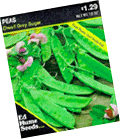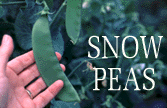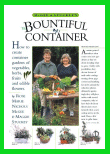
Elvis and the Year of the Pea
The how, what, when, where and why of growing peas
By Marion Owen, Fearless Weeder
for PlanTea, Inc. and
Co-author of Chicken Soup for the Gardener's Soul
FEATURE ARTICLE:

Tom Hanks' "Power of Four" solution
More good stuff:
Who is Marion Owen?
FAQs about PlanTea
Search Marion's articles, tips and recipes
Why grow organic?
News and press releases
Read love letters
How to link to this site
Need a speaker?
How to contact Marion
Visiting Alaska?
Come to Kodiak Island!
Go to home page

Marion's UpBeet Gardener
Newsletter has been
replaced by Marion's blog
which you can find at:
www.marionowen.wordpress.com
 The year 2004 marked a few special dates in history. Looking back to 1504,
this was the year Michelangelo completed David, the 16-foot sculpture
created from a single colossal block of marble. Moving up a couple centuries,
1804 was the year Haiti became the first black-governed republic in the
Western Hemisphere when it declared independence from France.
The year 2004 marked a few special dates in history. Looking back to 1504,
this was the year Michelangelo completed David, the 16-foot sculpture
created from a single colossal block of marble. Moving up a couple centuries,
1804 was the year Haiti became the first black-governed republic in the
Western Hemisphere when it declared independence from France.
Then in July of 1954, a shy 19-year-old truck driver named Elvis Presley recorded his first commercial single, "That's All Right!" which was aired to immediate success in Memphis.
Take one more step forward and you'll land in the present. Are you ready for this? The National Garden Bureau celebrated 2004 as:
The Year of the Pea
 The Year of the Pea might sound anticlimactic compared to Elvis' launch
to stardom, but peas are a star in many gardeners hearts. Just when you
are beginning to doubt that spring will ever come, you can trek out to
the garden and sow seeds of a crop that loves the cold a lot more than
you do.
The Year of the Pea might sound anticlimactic compared to Elvis' launch
to stardom, but peas are a star in many gardeners hearts. Just when you
are beginning to doubt that spring will ever come, you can trek out to
the garden and sow seeds of a crop that loves the cold a lot more than
you do.
With small white or purple-pink flowers, dainty-looking (but strong) and bright green pods, peas are a universal garden staple. They are hardy, easy to grow in gardens or containers, vigorous and nutritious. A cup of cooked snap peas checks in at only 34 calories, providing 1.4 grams of fiber, 2.6 grams of protein, and 5.6 grams of carbs along with a dose of vitamin C, iron, potassium and magnesium. All of this adds up to a marriage made in heaven for northern gardeners.

My favorite pea: Dwarf
Gray Sugar. An heirloom
pea with pink and purple blossoms from Ed
Hume Seeds
What's history without peas?
For centuries, peas enjoyed a popularity that rivaled today's sliced bread. During the Roman Empire however, peas were considered poisonous. Only dried peas were safe to eat.
 Then
came the Thirty Years War (1618-1648) which developed into a nasty struggle
for the balance of power in Europe. One day, a French gardener, looked
at the a wild pea bush and thought, "Perhaps I can do something to improve
this petit vegetable."
Then
came the Thirty Years War (1618-1648) which developed into a nasty struggle
for the balance of power in Europe. One day, a French gardener, looked
at the a wild pea bush and thought, "Perhaps I can do something to improve
this petit vegetable."
Soon, his field trials produced a green pea hybrid known as petits pois [pronounced PET-eet PWAH]. Fresh peas became all the rage at King Louis the XIV's court and its green roundness was soon enjoyed far and wide.
Captain Cook sailed with peas, sort of
In 1772, when Captain Cook was outfitting his ships for his 3-year voyage around the world, he insisted on taking cases of portable soups in the form of small, flat cakes. The soup, kept mainly for sick sailors, was mixed with pease flour. Pease is the old term for peas. Today, we recognize 3 kinds of peas. The difference lies in the way we eat them. The types are English peas, snow peas, and snap peas. Botanically, they all are varieties of Pisum sativum and belong, like beans, to the legume family.

While all three pea types need the same growing conditions, we're going to concentrate on snows and snaps, top performers in short growing seasons.
The snow pea is harvested when the peas inside the pod are immature. Stir frying is a popular way to prepare snow peas. The snap pea is more versatile because the pods can be harvested when the peas are immature or fully developed.
How to grow snow and snap peas
Select a spot that receives at least 6 hours of full sun daily. Peas prefer a fertile, somewhat sandy (or in our case, contains volcanic ash), neutral pH soil with good drainage. If necessary, dig compost or aged manure in to a depth of 6 to 8 inches. Go easy with the manure, because too much nitrogen encourages leaf growth, but few pea pods.

A cool weather crop, peas can germinate in soil temperatures in the low 40's, which means you can sow them as soon as the ground can be worked, as early as the first week in April. Be an attentive parent, though. If frost or a deep freeze threatens after they germinate, protect them with some sort of cover.
Sow seeds directly into the soil, as opposed to starting them early indoors, which creates more work than necessary. If the temperature is too cold (lower than 40 degrees) the seeds take longer to germinate and may rot. For a longer harvest period sow a batch of seeds every week or two.
Cover seeds with an inch or two of soil and water well. At this point, you'll want to keep an eye out for marauding crows and magpies who love to scratch and dig up buried green treasure. Provide support in the form of a trellis or fence. Guide the first tendrils onto the support until they get the idea.
Peas for container gardens
"Container gardeners have something of an edge here," says Rose Marie Nichols McGee, "for often you can position a container in a warmer or more sheltered spot where the soil won't freeze and where it will absorb sunlight for a quick winter warm-up." McGee, author of The Bountiful Container (available through Amazon), appreciates peas' versatile nature. "Container gardeners can expect to have a crop of peas two weeks earlier than traditional gardeners."

Available through Amazon.com
How peas graciously give back to the soil
As legumes, peas have the magic ability (I say magic, because man hasn't been able to duplicate the process) to "fix" nitrogen in the soil, which makes that important nutrient readily available to other plants. Pea plants also produce long root systems which help break up and aerate soil.
Why grow peas, anyway?
As if I haven't given enough reasons to grow peas, but there's one more consideration. It's a matter of flavor. Fresh peas are charged with a natural sugar that gives a hint of sweetness to their taste, and begins to turn to starch as soon as they are picked. Thus, no commercially harvested peas--out of season and flown in from another climate--can match the taste of one you picked 5 minutes ago. (For a unique pickle recipe, check out my dilly snap pea recipe).
Meanwhile, back to Elvis...
Next time you're in Memphis, stop by the little restaurant on Beale Street. You can order an adaptation of Elvis' favorite dishes, including a grilled peanut butter and banana sandwich, deep fried pickles and, dare I add this, mashed potatoes and peas. Which goes to show, that a diet which includes peas may not make you a rock 'n roll star, but it will surely change your life for the better.

Thanks for visiting and please stop by again. I'll put the coffee on!
Meet Marion Owen /// Learn about PlanTea /// Online Catalog /// Articles, Tips, Recipes /// Get free UpBeet Gardener newsletter /// Read current issue /// Listen to radio show /// Read news and press releases /// More resources and links /// Learn why 'grow organic?' /// View guidelines for retailers /// Read love letters /// Book Marion as a speaker /// Site map /// How to link to us /// Contact us /// Go to home page
PlanTea: The organic plant food in tea bags. http://www.plantea.com
Copyright ©1996 to present: PlanTea, Inc. All Rights Reserved. PO Box 1980, Kodiak, AK 99615-1980 USA
Questions or comments? marion@plantea.com Phone: Toll Free: 1-800-253-6331 (US and Canada); 907-486-2500